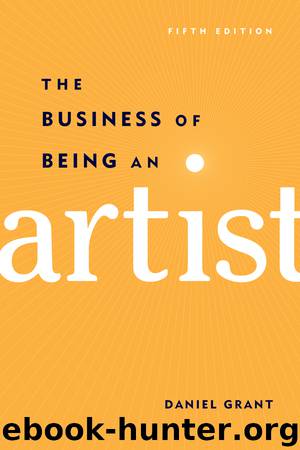The Business of Being an Artist by Daniel Grant

Author:Daniel Grant
Language: eng
Format: epub
Publisher: Allworth Press
Published: 2015-01-01T05:00:00+00:00
ARTISTS’ MORAL RIGHTS
As noted above, the Visual Artists Rights Act of 1990 represented a sea change in the legal protections afforded to artists by the federal government. The law is based on legal concepts established in French law for decades, including: the right to determine when a work has been completed (first brought to court by James MacNeil Whistler in 1900, later tested by the heirs of Georges Rouault); the right to always have one’s name credited with the work (including advertisements); and the right to prevent one’s work from being shown in a way that might harm the artist’s reputation (tested in the French courts by painter Bernard Buffet in 1962).
One of the first highly publicized instances of intentional distortion of a work of art occurred in 1958 when a black-and-white mobile by Alexander Calder, displayed in a building at the Greater Pittsburgh International Airport, was turned into a stationary sculpture and painted the city’s official colors, green and gold. A few years before that, sculptor David Smith condemned a purchaser of one of his painted metal sculptures for “willful vandalism” for removing the industrial green paint and, in 1980, the Bank of Tokyo outraged the art world when it removed a 1,600-pound aluminum diamond-shaped sculpture by Isamu Noguchi that hung in the bank’s New York City headquarters by cutting it into pieces.
The problem hasn’t been wholly confined to sculptors, as a mural by Arshile Gorky at the Newark (New Jersey) Airport was subsequently whitewashed and a painting by Pablo Picasso was cut into numerous one inch square pieces to be sold through magazine advertisements as “original” Picasso works of art by a couple of entrepreneurs in Australia. One of those Australians commented at the time, “If this works, we’re going to put the chop to a lot of Old Masters.”
Mutilation or destruction of an artist’s work (for which the artist owns the copyright) is now considered an infringement on copyright, with artists able to sue for both compensatory (out-of-pocket) and statutory (up to $20,000) damages as well as actual damages. Those actual damages refer to harm caused to an artist’s professional reputation by the destruction or distorted appearance of his or her work.
This kind of copyright infringement would not be a criminal violation—the copyright law does include possible jail terms and fines for instances of commercial exploitation, such as bootleg films, books, or records—since the damage or destruction of artwork is seen as an area for civil litigation. An artist must hire an attorney to bring action against someone altering or destroying his or her creations.
The general term of copyright protection does not apply to the moral rights created in this new federal law. Instead, the moral rights last for the life of the artist, the same period of coverage for invasion of privacy, libel, slander, and defamation of character. One aspect of the law of particular interest to muralists and wall sculptors concerns artwork that is attached to a building, and there are special rules that balance the rights of artists and property owners.
Download
This site does not store any files on its server. We only index and link to content provided by other sites. Please contact the content providers to delete copyright contents if any and email us, we'll remove relevant links or contents immediately.
Periodization Training for Sports by Tudor Bompa(7322)
The MacArthur Bible Commentary by John MacArthur(4225)
The Body: A Guide for Occupants by Bill Bryson(3787)
The Sports Rules Book by Human Kinetics(3580)
What It Really Takes to Get Into Ivy League and Other Highly Selective Colleges by Hughes Chuck(3217)
Marijuana Grower's Handbook by Ed Rosenthal(3112)
The Sprouting Book by Ann Wigmore(3046)
Salt, Fat, Acid, Heat: Mastering the Elements of Good Cooking by Nosrat Samin(2651)
The Martian by Andy Weir(2599)
Classic by Mary Berry(2498)
The Bread Bible by Rose Levy Beranbaum(2466)
Harry Potter 4 - Harry Potter and The Goblet of Fire by J.K.Rowling(2411)
The Marketing Plan Handbook: Develop Big-Picture Marketing Plans for Pennies on the Dollar by Robert W. Bly(2407)
Sapiens and Homo Deus by Yuval Noah Harari(2403)
Martha Stewart's Baking Handbook by Martha Stewart(2327)
50 Economics Classics by Tom Butler-Bowdon(2061)
Screenplay: The Foundations of Screenwriting by Syd Field(2050)
The Cambridge Grammar Of The English Language by Rodney Huddleston Geoffrey K. Pullum(2043)
The Plant Paradox by Dr. Steven R. Gundry M.D(2032)
